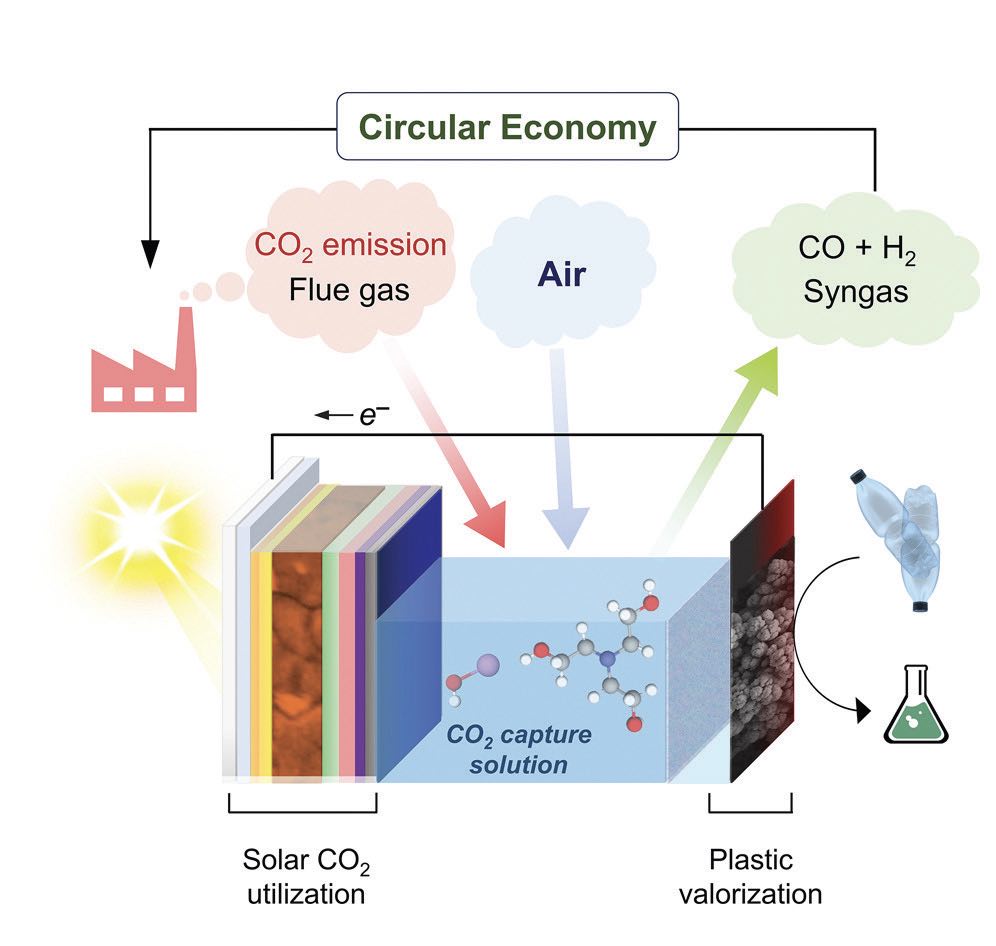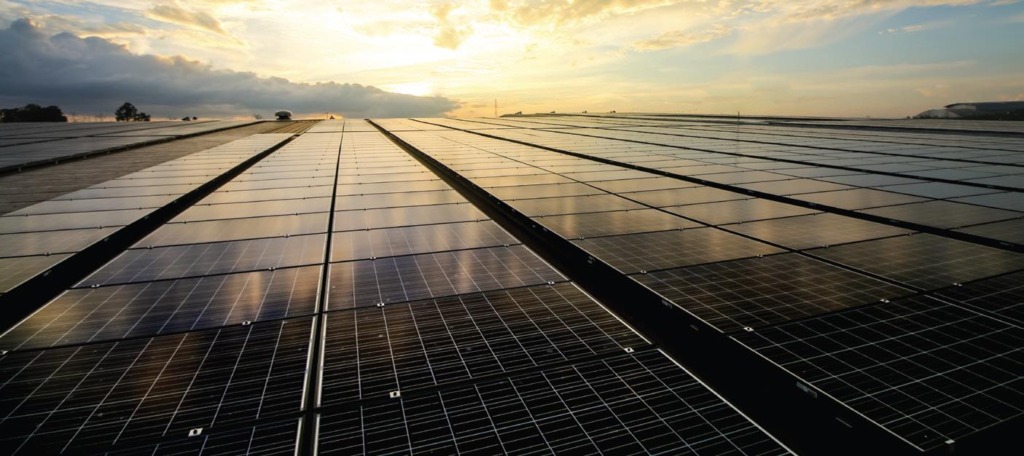Administration of the project
Production of synthesis gas from carbon dioxide using solar energy
By Dr. Neil Canter, Contributing Editor | TLT Tech Beat October 2023
This newly developed process has the potential to offer a sustainable pathway for producing gas-to-liquid base stocks using the Fischer Tropsch process.
• A photoelectrocatalytic reduction process was developed that not only converts carbon dioxide to syngas but also oxidizes waste plastic-derived ethylene glycol to glycolic acid.
• Initial work involved evaluation of concentrated carbon dioxide, flue gas and air.
• The balance required between the capture and utilization steps depends upon the concentration of carbon dioxide available.
Research is ongoing to identify cost effective pathways for converting the greenhouse gas carbon dioxide into useful derivatives that can be used as building blocks to manufacture lubricant base stocks and additives. One process that is actively under evaluation is the photoelectrocatalytic carbon dioxide reduction reaction.
In a previous TLT article,1 a new type of catalyst was reported that combines copper with nickel to convert carbon dioxide to carbon monoxide and then to the hydrocarbon, ethylene. The copper, nickel hybrid catalyst was used at an optimum ratio of 10:1 under alkaline pH conditions. A Faradaic efficiency of 66% was achieved with this hybrid catalyst. Better selectivity for ethylene was obtained as the reaction conditions minimized the transformation of water to hydrogen.
Utilizing carbon dioxide captured by current approaches has proven to be expensive and to require a large amount of energy. Dr. Sayan Kar, postdoctoral scientist in the Yusuf Hamied department of chemistry at the University of Cambridge in Cambridge, UK, says, “The current approach is to capture carbon dioxide in alkanolamine solutions, and then use desorption and compression steps to produce a pure carbon dioxide stream that involves heating up solutions at temperatures up to 100 C. Carbon dioxide desorbs at this high temperature, which is then used for various purposes, but this is an energy intensive process. The challenge is to overcome the thermodynamic stability of captured carbon dioxide without requiring significant energy.”
A more efficient approach is to directly capture carbon dioxide and then convert it into a derivative through a sustainable method such as the use of solar energy. Kar says, “We have been working to utilize sunlight to capture and convert carbon dioxide over the past five or six years using a series of heterogeneous catalysts.
Kar, his colleagues Dr. Motiar Rahaman, senior postdoctoral scientist and Marie-Curie Fellow, and Dr. Erwin Reisner, professor of energy and sustainability, have now developed a process using solar energy to efficiently convert captured carbon dioxide into syngas, which is a combination of carbon monoxide and hydrogen. Of interest to the lubricant industry is that this process has the potential to offer a sustainable pathway for producing gas-to-liquid base stocks using the Fischer Tropsch process.
Solar-driven photoelectro-chemical (PEC) process
The researchers developed an approach that combines carbon dioxide capture and reduction to syngas with oxidation of waste plastic-derived ethylene glycol to glycolic acid. The latter intermediate has applications in the pharmaceutical, food and textile industries. The solar-driven photoelectrochemical (PEC) process is shown in Figure 3. A two-compartment, three-electrode setup was used.

Figure 3. This photoelectrocatalytic reduction process is the only solar drive process for utilizing captured carbon dioxide. Figure courtesy of the University of Cambridge.
Kar says, “We used a cobalt (II) phthalocyanine molecular catalyst in the carbon dioxide reduction process because this substance works well in producing syngas at lower overpotentials. Carbon dioxide capture was achieved through the use of aqueous solutions of amines such as monoethanolamine (MEA) and triethanolamine (TEA) as well as sodium hydroxide.” The catalyst was immobilized on multi-walled carbon nanotubes, then drop-cast on a graphite foil substrate, and finally attached to a perovskite solar cell to produce the photocathode.
The initial challenge facing the researchers was to identify a complementary oxidation process to work with the carbon dioxide reduction reaction. Oxidation of water was attempted, but the researchers determined that low carbon monoxide production was obtained, due to the difficulty of the water oxidation process.
Kar says, “To overcome the issue of water oxidation, we switched to a strategy using ethylene glycol oxidation obtained from discarded polyethylene terephthalate plastic waste. This allowed us to increase our production of synthesis gas by carbon dioxide reduction, and at the same time to upcycle plastic waste to useful chemical derivatives that would otherwise go to a landfill. A copper palladium alloy electrodeposited on a nickel foam was used as the anode to catalyze the oxidation of ethylene glycol to glycolic acid under alkaline conditions.”
A concentrated carbon dioxide (99.995%) gas stream was used in the first series of tests. The faradaic efficiency for syngas formation was found to be greater than 95%, and the carbon monoxide to hydrogen ratio in this product was 1:2.
Kar says, “TEA was selected as the amine for use with the high purity carbon dioxide stream because the MEA adduct of carbon dioxide is too thermodynamically stable. The result is that carbon dioxide is not as readily available to be converted to carbon monoxide in the reduction step. As a weaker base, the TEA adduct of carbon dioxide is not as stable.”
The successful demonstration of the PEC process led the researchers to determine additional steps toward commercialization by evaluating two common gas streams that contain carbon dioxide: flue gas and air. Flue gas is a post-combustion process produced from large industrial plants and also from automotive exhaust. A simulated flue gas stream containing 15% carbon dioxide, 4% oxygen and 81% nitrogen was used. Air with an ultra-dilute concentration of carbon dioxide (approximately 420 ppm) also was evaluated.
In both cases, the conversion to carbon monoxide and syngas was lower. Kar says, “The ratio of carbon dioxide to hydrogen in the flue gas experiments was 1:4 and in the evaluation of air was 1:30. We also found that carbon dioxide capture from air was best handled using the more alkaline bases, sodium hydroxide, as compared to TEA.” The need to adjust the PEC depending upon the concentration of carbon dioxide available highlights the balance required between the capture and utilization steps.
Rahaman says, “Our ability to demonstrate this approach, the only solar-driven process for utilizing captured carbon dioxide, leads us to optimize the system to increase conversion to syngas. The solar cell also has proven to be able to operate successfully for days. We are working to extend the durability from days to years. Ultimately, an approach needs to be found to move this process from the lab scale to the commercial scale.”
Kar mentioned that future work also will involve developing pathways to use the PEC process to manufacture methanol and ethanol from carbon dioxide. Additional information can be found in a recent article2 or by contacting Reisner at [email protected].
REFERENCES
1. Canter, N. (2023), “Conversion of carbon dioxide to ethylene,” TLT, 79 (5), pp. 20-21. Available here.
2. Kar, S., Rahaman, M., Andrei, V., Bhattacharjee, S., Roy, S. and Reisner, E. (2023), “Integrated capture and solar-driven utilization of CO2 from flue gas and air,” Joule, 7 (7), pp. 1496-1514.
Neil Canter heads his own consulting company, Chemical Solutions, in Willow Grove, Pa. Ideas for Tech Beat can be submitted to him at [email protected].
Original article in TLT magazine: https://www.stle.org/files/TLTArchives/2023/10_October/Tech_Beat_III.aspx


Be the first to comment